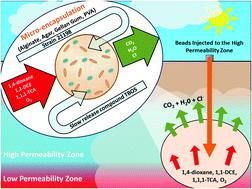当前位置:
X-MOL 学术
›
Environ. Sci.: Processes Impacts
›
论文详情
Our official English website, www.x-mol.net, welcomes your feedback! (Note: you will need to create a separate account there.)
Co-encapsulation of slow release compounds and Rhodococcus rhodochrous ATCC 21198 in gellan gum beads to promote the long-term aerobic cometabolic transformation of 1,1,1-trichloroethane, cis-1,2-dichloroethene and 1,4-dioxane.
Environmental Science: Processes & Impacts ( IF 5.5 ) Pub Date : 2020-02-11 , DOI: 10.1039/c9em00607a Mitchell T Rasmussen 1 , Alyssa M Saito 1 , Michael R Hyman 2 , Lewis Semprini 1
Environmental Science: Processes & Impacts ( IF 5.5 ) Pub Date : 2020-02-11 , DOI: 10.1039/c9em00607a Mitchell T Rasmussen 1 , Alyssa M Saito 1 , Michael R Hyman 2 , Lewis Semprini 1
Affiliation

|
Rhodococcus rhodochrous ATCC 21198 (strain ATCC 21198) was successfully co-encapsulated in gellan gum beads with orthosilicates as slow release compounds (SRCs) to support aerobic cometabolism of a mixture of 1,1,1-trichloroethane (1,1,1-TCA), cis-1,2-dichloroethene (cis-DCE), and 1,4-dioxane (1,4-D) at aqueous concentrations ranging from 250 to 1000 μg L-1. Oxygen (O2) consumption and carbon dioxide (CO2) production showed the co-encapsulated cells utilized the alcohols that were released from the co-encapsulated SRCs. Two model SRCs, tetrabutylorthosilicate (TBOS) and tetra-s-butylorthosilicate (T2BOS), which hydrolyze to produce 1- and 2-butanol, respectively, were encapsulated in gellan gum (GG) at mass loadings as high as 10% (w/w), along with strain ATCC 21198. In the GG encapsulated beads, TBOS hydrolyzed 26 times faster than T2BOS and rates were ∼4 times higher in suspension than when encapsulated. In biologically active reactors, the co-encapsulated strain ATCC 21198 effectively utilized the SRC hydrolysis products (1- and 2-butanol) and cometabolized repeated additions of a mixture of 1,1,1-TCA, cis-DCE, and 1,4-D for over 300 days. The transformation followed pseudo-first-order kinetics. Vinyl chloride (VC) and 1,1-dichloroethene (1,1-DCE) were also transformed in the reactors after 250 days. In the long-term treatment, the batch reactors with co-encapsulated T2BOS GG beads achieved similar transformation rates, but at much lower O2 consumption rates than those with TBOS. The results demonstrate that the co-encapsulation technology can be a passive method for the cometabolic treatment of dilute groundwater plumes.
中文翻译:

缓释化合物和Rhodococcus rhodchrous ATCC 21198在结冷胶珠中的共包封可促进1,1,1-三氯乙烷,顺式1,2-二氯乙烯和1,4-二恶烷的长期有氧代谢性转化。
杜鹃红球菌ATCC 21198(ATCC 21198菌株)与原硅酸盐成功地共包封在吉兰糖胶珠中,作为缓释化合物(SRC),以支持1,1,1-三氯乙烷(1,1,1-TCA)混合物的有氧代谢),顺式1,2-二氯乙烯(cis-DCE)和1,4-二恶烷(1,4-D)的水溶液浓度范围为250至1000μgL-1。氧气(O2)的消耗和二氧化碳(CO2)的产生表明,共包封的细胞利用了从共包封的SRC中释放出的醇。两种水解型SRC,分别水解生成1-丁醇和2-丁醇的原硅酸四丁酯(TBOS)和原硅酸四丁酯(T2BOS),以高达10%(w / w)的质量负载封装在吉兰糖胶(GG)中w),以及ATCC 21198菌株。在GG包封的磁珠中,TBOS的水解速度比T2BOS快26倍,悬浮速率比封装时高约4倍。在具有生物活性的反应器中,共包封的菌株ATCC 21198有效利用了SRC水解产物(1-丁醇和2-丁醇),并重复代谢了1,1,1-TCA,顺式DCE和1,4的混合物-D超过300天。该转变遵循伪一级动力学。250天后,氯乙烯(VC)和1,1-二氯乙烯(1,1-DCE)也在反应器中转化。在长期处理中,具有共包封的T2BOS GG珠的间歇式反应器实现了相似的转化率,但与TBOS相比,其O2消耗率低得多。结果表明,共包封技术可以作为一种被动方法,用于淡水羽流的新陈代谢处理。
更新日期:2020-02-11
中文翻译:

缓释化合物和Rhodococcus rhodchrous ATCC 21198在结冷胶珠中的共包封可促进1,1,1-三氯乙烷,顺式1,2-二氯乙烯和1,4-二恶烷的长期有氧代谢性转化。
杜鹃红球菌ATCC 21198(ATCC 21198菌株)与原硅酸盐成功地共包封在吉兰糖胶珠中,作为缓释化合物(SRC),以支持1,1,1-三氯乙烷(1,1,1-TCA)混合物的有氧代谢),顺式1,2-二氯乙烯(cis-DCE)和1,4-二恶烷(1,4-D)的水溶液浓度范围为250至1000μgL-1。氧气(O2)的消耗和二氧化碳(CO2)的产生表明,共包封的细胞利用了从共包封的SRC中释放出的醇。两种水解型SRC,分别水解生成1-丁醇和2-丁醇的原硅酸四丁酯(TBOS)和原硅酸四丁酯(T2BOS),以高达10%(w / w)的质量负载封装在吉兰糖胶(GG)中w),以及ATCC 21198菌株。在GG包封的磁珠中,TBOS的水解速度比T2BOS快26倍,悬浮速率比封装时高约4倍。在具有生物活性的反应器中,共包封的菌株ATCC 21198有效利用了SRC水解产物(1-丁醇和2-丁醇),并重复代谢了1,1,1-TCA,顺式DCE和1,4的混合物-D超过300天。该转变遵循伪一级动力学。250天后,氯乙烯(VC)和1,1-二氯乙烯(1,1-DCE)也在反应器中转化。在长期处理中,具有共包封的T2BOS GG珠的间歇式反应器实现了相似的转化率,但与TBOS相比,其O2消耗率低得多。结果表明,共包封技术可以作为一种被动方法,用于淡水羽流的新陈代谢处理。


























 京公网安备 11010802027423号
京公网安备 11010802027423号